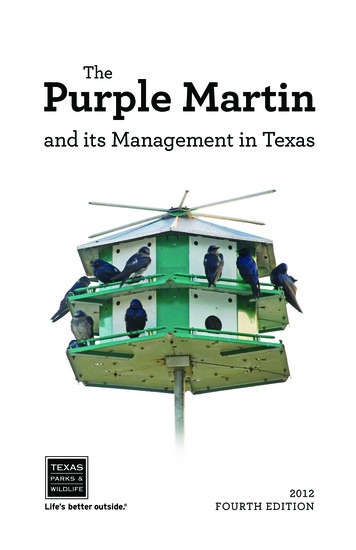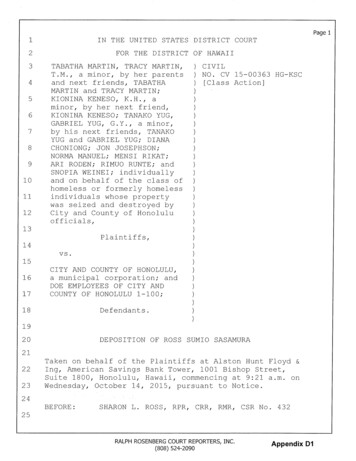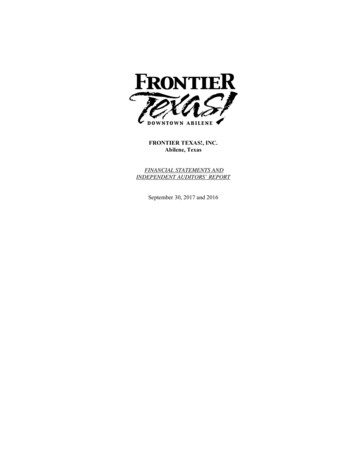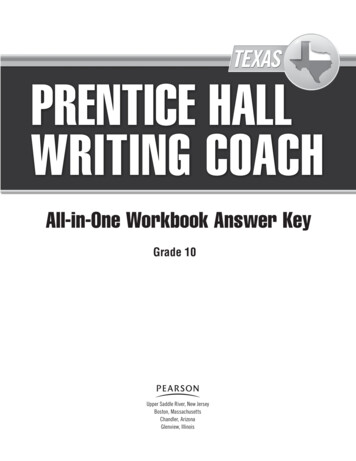
Transcription
ThePurple Martinand its Management in Texas2012FOURTH EDITION
About the AuthorJ A ME S D. RAYJim Ray has a passion for Purple Martins.A native Texan, this 23-year veteran of the wildlife managementand research community in Texas and the Central Flyway hasworked to publicize and expand martins as a nesting species inwest Texas. His work with Purple Martins includes promotionof their management through presentations and publications.Additionally, since 1997 he has banded more than 10,000 ofthese popular migratory songbirds.Jim is credited with more than a dozen publications on PurpleMartins, and two of the three previous editions of this bulletinwon publication of the year honors from his professionalorganization, The Texas Chapter of The Wildlife Society.Other of his publications on martins have appeared in thePurple Martin Update (quarterly publication of the Purple MartinConservation Association), the Texas Breeding Bird Atlas cc.html), andTexas Wildlife (Texas Wildlife Association). He has alsocontributed numerous articles to newspapers and newsletters.– Louise Chambers, Purple Martin Conservation Association
ThePurple Martinand its Management in TexasWritten by James D. Ray,formerly of Texas Parks and Wildlife DepartmentPresent address:Babcock and Wilcox Technical ServicesPantex, LLCPantex Plant, Bldg. T-9061P.O. Box 30020Amarillo, Texas 79120-0020This booklet is dedicated to the thousands of past, present andfuture martin landlords in Texas.The assistance of those who contributed their time and talent tothis and prior editions is gratefully acknowledged. Critical reviewson various drafts and editions were provided by Noreen Damude,Carl Frentress, Mark Klym, Gene T. Miller, Calvin Richardson,Cliff Shackelford, Matt Wagner (TPWD), James R. Hill, III (PurpleMartin Conservation Association), and David Hurt (WildBirdsUnlimited). Mr. Hill and Louise Chambers of the Purple MartinConservation Association are greatly acknowledged for supplyingthe photographs, as well as their other contributions utilized inthis booklet.
The Purple Martin and its Management in Texas 1Table of ContentsForeword . 3Background . 5Life History . 8Housing .12Placement of Martin Houses .16Additional Tips for Attracting Purple Martins.18Problem Management . 20The Importance of Pre-Migratory Roosts .24Purple Martins: One of Life’s Sweet Rewards.25Frequently Asked Questions . 26Information and Technical Assistance . 29What You Should Do if You Findor Observe Banded Birds . 29Summary. 30Sources of Information . 30
2 The Purple Martin and its Management in Texas
The Purple Martin and its Management in Texas 3ForewordThe Purple Martin (Progne subis) has been managed intentionally byhumans longer than any other North American songbird. For hundreds,perhaps thousands of years, Native American tribes in what is now thesoutheastern United States hung clusters of hollowed-out gourds to attractthis large swallow to their villages (Figure 1). Native Americans may haveappreciated the Purple Martins’ beauty, song, or penchant for consumingannoying or depredating flying insects. James R. Hill, III, founder of thePurple Martin Conservation Association, offers the following speculationregarding benefits of Purple Martins that Native Americans may haveenjoyed:Perhaps, Purple Martins were like alarm clocks, awakening thevillage inhabitants with their singing early and regularly eachmorning. Maybe they served as biological calendars, since everyphase of their annual life cycle (from arrival in spring, pairing,nest-building, egg-laying, hatching, fledging and departure) is doneon a regular and predictable schedule. They might have been likewatchdogs, since they are notorious for giving alarm calls whenpredators or strangers approach the colony site.FIGURE 1.Purple Martinslived in closeassociation withNorth Americanseven before thefirst Europeansettlers arrived.[Courtesy ofGerard Frisheteauand thePurple MartinConservationAssociation.]
4 The Purple Martin and its Management in TexasWhatever the reason, certain tribes provided housing for Purple Martins,and the early settlers were quick to follow. Today, an estimated 1 millionNorth Americans provide housing for Purple Martins.Natural nesting sites of Purple Martins include cavities in trees and treesnags, saguaro and organ pipe cacti, niches in cliff faces, and even on theground between large boulders. Historically, most nesting probablyoccurred in woodpecker holes in tree snags (tree hollows), and, as evidencedby today’s western Purple Martins, many may have nested in the hollowsof live trees. Tree snag habitat, especially east of the Rocky Mountains, islimited due to susceptibility to weather and fire, suitability for fire wood,and to losses to urban sprawl, “clean farming” and logging.Competition for available cavities occurs among our native cavity-nestingspecies; however, competition for cavities has been intensified by the introduction of the non-native House Sparrow and European Starling. For thesereasons, human-provided housing and management has become vital toPurple Martins, especially east of the Rocky Mountains, where they haveundergone a complete “tradition shift” and are now the only bird speciesentirely dependent on humans for supplying them with nesting cavities.Consequently, the purpose of this booklet is to acquaint landowners, homeowners, bird enthusiasts and the general public with Purple Martins andtheir management needs.
The Purple Martin and its Management in Texas 5BackgroundThe Purple Martin is one of eight species of swallows that regularly occurin the United States. All of these — the Bank, Barn, Cave, Cliff, NorthernRough-winged, Tree and Violet-green swallows, and the Purple Martin —nest in Texas. All members of the swallow family are aerial insectivores,although the Tree Swallow is capable of surviving on berries and seeds ifflying insects become temporarily unavailable. All species of swallows aregregarious to some degree. All are “cavity” nesters, displaying varioustechniques of securing nest sites. Some swallows nest in existing cavities(the Tree Swallow, Violet-green Swallow and Purple Martin), some dig theirown cavity in steep embankments (the Bank Swallow and Northern Roughwinged Swallow), some construct cavities with mud (the Cliff Swallow), andsome complete a “cavity” by constructing a mud bowl under ledges in cavesor on man-made structures (the Barn Swallow and Cave Swallow).Purple Martins are widely distributed in North America (Figure 2). In Texas,they occur primarily east of a line that runs just west of Monahans, Lubbock,FIGURE 2. Purple Martins breed throughout much of North America.[Map courtesy of the Purple Martin Conservation Association.]
6 The Purple Martin and its Management in TexasFIGURE 3. Purple Martins breed in allbut the Trans-Pecos and western thirdof the Panhandle and South Plains.Amarillo and Spearman (Figure 3). West of that line, nesting Purple Martinsare rare , if present at all. Properly managed housing west of that line couldallow for the westerly expansion of their range in Texas. Their rarity there islikely a function of cavity limitations rather than water limitations. For example, Purple Martins can be found nesting in the Sonoran desert of Arizona,where surface water is scarce, but cavities in saguaro and organ pipe cacti areabundant. They also occupy areas in the nearly treeless High Plains wherethey would otherwise be absent, if not for housing supplied by humans. In thePanhandle, in recent years, they have displayed good potential for productionand expansion, when provided proper, well-placed and managed housing.The Purple Martin is North America’s largest swallow. They weigh approximately 1.75 ounces (50 grams) and have a wing span of approximately 15 inches.Purple Martins have broader wings and tails and a more soaring flight than doother swallows. Males do not acquire their adult plumage until their secondwinter. Adult males are a glossy blue-black above and below, and females areduller, with a sooty-gray forehead, gray neck and grayish underparts (Figure 4).Purple Martin males in their second calendar year of life can be sexed andaged by subtle plumage differences, but it is difficult; they resemble femalesexcept for dark spotting on their chin, throat, breast, flanks or undertailcoverts. Young-of-the-year Purple Martins also resemble females and arereferred to as juveniles or hatch-year birds. Subadults returning to NorthAmerica for their first nesting season are known as second-year (SY) martins,and the adults are referred to as after-second-year (ASY) martins.
The Purple Martin and its Management in Texas 7Purple Martins are aerial insectivores that do most of their feeding at 100–200 feet above the ground. Their diet is almost 100 percent flying insects,and they opportunistically feed on flying ants, beetles, butterflies, cicadas,damselflies, dragonflies, (drone) bees, flies, grasshoppers, hoverflies, katydids, mayflies, midges, mosquitoes, moths, stinkbugs and wasps. Manymartin “landlords” mistakenly believe that Purple Martins devour largequantities of mosquitoes. Actually, no scientific study has ever shownmosquitoes to comprise more than 3 percent of the Purple Martin’s diet.Most mosquito species are simply not available for Purple Martin consumption due to their nocturnal and low-flying habits.Though Purple Martins may be most numerous around water, a nearbywater source is not a prerequisite for having them. However, Purple Martinswill travel several miles to a water source to drink and bathe on the wing.Water bodies are also used as feeding areas, because they generally havehigher densities and a greater diversity of flying insects than do mostupland habitats.FIGURE 4. The all-dark adult male Purple Martin can easily be differentiatedfrom the adult female (light breast).
8 The Purple Martin and its Management in TexasLife HistoryThe Purple Martin is one of the earliest neotropical migratory birds to returnto the United States each year. After spending approximately five months inSouth America, Purple Martins make their appearance in Texas during thefirst half of February (Figure 5). Sometimes individuals arrive as early asJanuary. During colder springs, Purple Martins may not appear in northernparts of the Panhandle until late March. The migration of Purple Martins isprolonged, with migrants continuing to arrive at colony sites for 12 to 16 weeks.Males generally arrive before the females of their same age. The oldestPurple Martins (five- to seven-year-olds) generally are the first to arrive.These are followed by the three- to four-year-olds, and then the two-year-olds.Normally, SY Purple Martins do not begin arriving until about five weeksafter the earliest ASY martins appear. It is these SY Purple Martins thatgenerally establish new colony sites.Martin landlords often refer to the earliest arrivals in spring as “scouts.” Tothousands of landlords, the arrival of the first Purple Martin scout of theseason is the sure sign of approaching spring. Contrary to popular belief, thescouts do not return to South America to guide their colony back to the site.FIGURE 5. The isochronal (date)lines shown on this map mark theaverage first-arrival dates of adultmartins at long-established breeding sites. Adult martins typicallybegin arriving within one to twoweeks on either side of these dates.“Landlords” with younger (orsmaller) colonies typically experience slightly later return dates.Second-year martins, the only agegroup that will typically colonizenew breeding sites, don’t beginarriving until about five weeksafter the earliest adults do. Thesesubadult martins continue arrivingfor an additional 12 to 16 weeks.
The Purple Martin and its Management in Texas 9This misconception is spurred by the common observation of a PurpleMartin or two arriving, only to quickly disappear for a few days or longer.This phenomenon can be explained by one or more of the following. Duringprolonged cold and/or wet weather, early-arriving Purple Martins oftenbecome inactive in their houses and/or form communal roosts, wherebymany martins pack into a single cavity to conserve heat and energy. Also,these “early birds” may be brief visitors on their way to more northerlynesting sites. They are simply using martin houses for overnight stopsor to rest for a day or two during migration.Purple Martin colonies in excess of 350 pairs have been reported. PurpleMartins are considered colonial in that two or more pairs will nest in closeproximity to each other. A Purple Martin colony is simply a random aggregation of individual birds attracted to a common breeding site. Once PurpleMartin broods fledge, individuals that make up the colony disperse from thecolony site independently from other colony members. Except by accident,they do not migrate as a colony, nor do they assemble as a colony until thefollowing spring when they return independently to the site at which theybred the previous year. Colonial nesting has advantages to Purple Martinsin both nest defense and creating “safety in numbers.” However, the drivingforce behind colonial nesting in Purple Martins may be the increased opportunity for males to pass on genetic material to offspring other than thoseproduced in the single brood of his own mate. Males frequently force-copulatewith other females in the colony, thus fathering more offspring than justthose produced in their own nest. Purple Martins are a single-broodedspecies but on rare occasions, in Texas, are known to raise two broods.Generally, most Purple Martins breed as subadults. However, most colonysites will have a small percentage of non-breeding bachelor (SY) males. Onaverage, about 70 percent of the breeding males at the colony site will beASY, and 30 percent will be SY males. Upon arrival, males spend a greatdeal of time exploring cavities at the colony site. Following selection of oneor more nest cavities, the males await the arrival of females. Males advertisetheir selected cavity by performing the “claiming-reclaiming” display. Thisdisplay involves flying from the cavity, gliding around, re-entering the cavity,turning and singing in the entrance. Although this activity stimulates theinterest of arriving females, the female actually selects a cavity, thus inheriting the male whose cavity she chooses. Pairs become established after a fewhours to a few days. Nesting is quite staggered at most colony sites because
10 The Purple Martin and its Management in Texasof age-related differences in return schedules. Some pairs will be fledgingyoung while others are still incubating eggs.Nest construction is a contagious activity. Once a few pairs begin, many othersquickly become active in nest building. The nest is constructed by both sexes.Coarse materials such as twigs, straw, pine needles and coarse grasses are thepreferred nest materials. Often, a mud dike, sloping towards the rear of thecavity, is constructed near the entrance. Prior to egg laying, the nest cup islined with green leaves, plucked from the tops of nearby trees and shrubs.Green leaves are added throughout the egg laying and incubation periods. Itis hypothesized that green leaves contain a natural insecticide to help reduceparasite numbers, or aid in maintaining sufficient moisture for the eggs.Three to seven eggs (average four to six) are laid and incubated by the femalefor 16 days (Figure 6). On average, but varying with temperature, incubationsessions by the female consist of her being on and off the nest at 15-minuteintervals. In the female’s absence, the male sits on the eggs, though he lacksthe “brood patch” required for true incubation. A brood patch is the featherlessarea of skin on the belly of incubating birds that allows for heat transfer fromthe brooding parent to the developing embryo within the egg.The young are fed small insects at first, which are increased in size as theyoung birds grow. This continues until the young birds fledge after about28 days. After fledging, the brood is kept together for one to two weeks,returning to the nest cavity for awhile for the night and/or during daytimethunderstorms. Shortly after fledging, martins begin pre-migratory flockingand soon return to South America. By the end of September, most PurpleMartins have left Texas for the wintering grounds. Ninety percent of thePurple Martin population is believed to winter in and around the state ofSão Paulo, Brazil. Others can be found east of the Andes from Venezuelanorth to northern Bolivia.Banding has shown that most Purple Martins live one to two years. Therecord longevity for Purple Martins in the wild is 13 years. The annualmortality rate is 50 percent for adult Purple Martins and 60–70 percent forjuveniles. Adult (ASY) martins are extremely faithful to colonies, returningyear after year. Only about 5 to 10 percent of SY Purple Martins return totheir natal colony. The remainder disperse to other established colonies, orto colonize unestablished sites.
The Purple Martin and its Management in Texas 11FIGURE 6.Purple Martin nests arenormally comprised offour to six eggs on a“pad” of coarse nestmaterials. Green leavestypify a completedmartin nest.
12 The Purple Martin and its Management in TexasHousingPurple Martins can be attracted to our yards with a variety of housing types.Most housing consists of plastic or hollowed-out natural gourds (“birdhouse”or “bottle”) or conventional houses made of aluminum or wood. A combination of gourds and conventional housing (Figure 7) may more than doubleyour chances of attracting martins. Advantages and disadvantages of woodenand aluminum houses and of natural and plastic gourds are discussed inFigure 8.Cavities should be no smaller than 6 inches wide x 6 inches high x 6 inchesdeep, but larger cavities (e.g., 7 inches wide x 6 inches high x 12 inches deep)are preferred by Purple Martins and reduce the chances of predation byhawks, owls and other predatory birds. Gourds should be at least 7 inches indiameter, but those of 8 to 13 inches are preferred.To facilitate management (e.g., cleaning, control of nest-site competitors,and record keeping) each cavity must be accessible individually. Woodenhouses can be constructed with this in mind, and most reputable manufacturers of aluminum houses now incorporate this into their design. Plasticgourds equipped with screw-off access doors are now available commercially,and natural gourds can easily be equipped with access doors using jar tops.Circular entrance holes to martin housing should be between 1-7/8 inchesand 2-3/8 inches, but 2-1/8 inches is best. All Purple Martin housing (gourdsincluded) should be painted white. Purple Martins seem to prefer whitehousing, possibly because dark entrance holes and the birds themselves(Purple Martins) show up better against a white background and are thusseen more easily by house-seeking martins. More importantly, white is anexcellent reflector of heat, which can be deadly to young Purple Martins innest cavities. White, polyurethane, high-gloss enamel paint is recommended.Other essential housing specifications are included in the ProblemManagement chapter of this booklet.
The Purple Martin and its Management in Texas 13FIGURE 7. Offering two or more types of housing may enhance yourchances of attracting that first pair of Purple Martins.
14 The Purple Martin and its Management in TexasFIGURE 8.Advantages and disadvantages of gourds, and wooden and aluminum conventional housing.GOURDS (8 inches or larger)Natural:PROS Cooler in hot weather and warmer in cold weatherthan aluminum houses; equal to wooden houses Inexpensive–can be home grown Larger cavities than standard conventional housing Light weight for vertical raising and lowering Natural–aesthetically pleasing Predators have difficulty clinging to and accessing Swing and sway, which martins like, andcompetitors and predators dislike Wider spacing of cavities and lack of commonporches connecting entrance holes results in higheroccupancy rates than in conventional houses Lack of continuous porches prevents oldernestlings from entering neighboring compartmentsto steal food from younger nestlingsCONS Harder to access and clean (unlessyou install screw-off access doors,using jar tops) Not commonly available Require more care for longevityGOURDS (8 inches or larger)Plastic:PROS Can be purchased commercially with screw-offaccess doors and molded-in rain canopies Larger cavities than standard conventional housing Light weight for vertical raising and lowering Natural–aesthetically pleasing Predators have difficulty clinging to and accessing Swing and sway, which martins like, andcompetitors and predators dislike Wider spacing of cavities and lack of commonporches connecting entrance holes results in higheroccupancy rates than in conventional houses Some can be equipped with sparrow/starling traps Lack of continuous porches prevents oldernestlings from entering neighboring compartmentsto steal food from younger nestlings Some come with starling-resistant entrancesCONS Harder to access and clean (unlessequipped with screw-off access doors,using jar tops)
The Purple Martin and its Management in Texas 15CONVENTIONAL HOUSESWooden:PROS Can be “tailor-constructed” (cavity size,appearance, entrance shape, etc.) Remain slightly cooler in hot weather andwarmer in cool weather than aluminumhousesCONS Most designs have cavities that are hard toaccess and clean Standard commercial cavity size of6" x 6" x 6" is the minimum size purplemartins will accept Too heavy for easy raising and lowering(except with winch systems) Encourages older nestlings to enter neighboring compartments to steal food from youngernestlings, unless equipped with some form ofporch divider or non-continuous porchCONVENTIONAL HOUSESAluminum:PROS Light weight for vertical raising and lowering Most can be modified to have larger cavities Most have easy-opening compartments forcleaning Available commercially Some have House Sparrow traps asaccessories Some have owl guards available asaccessories Some have porch dividers available asaccessories Some come with starling-resistant entrances,or have them as accessoriesCONS Standard commercial cavity size of6" x 6" x 6" is the minimum size purplemartins will accept Encourages older nestlings to enter neighboring compartments to steal food from youngernestlings, unless equipped with some form ofporch divider or non-continuous porchNOTE: Although nest cavities with dimension of greater than 6" x 6" x 6"are preferred by martins, they are also more attractive to European Starlings.Consequently, be sure to employ entrances touted as startling-resistant.
16 The Purple Martin and its Management in TexasPlacement of Martin HousesFor ease of management (including record keeping), martin housing shouldbe erected on poles designed for easy raising and lowering. Landlords needto vertically lower their housing at least weekly (if not daily) to evict unwelcome House Sparrows and European Starlings, without disturbing or dumpingcontents of Purple Martin nests. Raising and lowering of martin housing,even daily, will not cause Purple Martins to abandon their nest or their colonysite. Vertical-raising martin pole systems (telescoping, pulley or winch) areavailable commercially. Conventional martin houses made of wood tend tobe heavier than aluminum martin houses or gourd setups, and may pose aproblem for easy raising and lowering. However, on a proper pole system,housing made of wood provides excellent homes for Purple Martins.Poles for martin housesshould be mounted inconcrete or within a groundsocket embedded in concrete(Figure 9). Poles and housesmust be mounted in ways thatwill not allow the housing toturn in the wind. PurpleMartins may abandon nests ifthe orientation (direction) oftheir cavity changes. Also,Purple Martins often abandongourds if the gourds are hungin such a manner that theystrike one another or otherobjects in high winds.FIGURE 9. Martin house poles can be easily removed for relocation, if installed in aground socket. An 18- to 24-inch section of pipe can be used, but commercial groundsockets are available. These have a clamp at the upper end which prevents a pole fromrotating inside of the ground socket.
The Purple Martin and its Management in Texas 17Martin housing should not be erected or opened (unplugged) until one totwo weeks prior to the average return dates shown in Figure 5. Erectinghousing earlier than that will only result in unnecessary battles with HouseSparrows and European Starlings. SY Purple Martins, the only age groupthat w ill typically colonize new breeding sites, don’t typically begin arrivinguntil about five weeks after the earliest ASY martins. Consequently, martinhousing at unestablished sites need not be made available until four weeksafter the average return dates shown in Figure 5. An exception to this rule isthat ASY martins can occasionally be lured away from active colony sitesless than one mile away if you offer superior housing and/or management,or if they failed to fledge young at another site during the previous nestingseason. Prospective landlords that opt to open their housing earlier than therecommended time must dedicate themselves to frequent and consistentmanagement against House Sparrows and starlings. Martin housing shouldbe taken down or closed up at active colony sites soon after Purple Martinshave ended their daily visits following fledging of the young. Martin housingshould be left up until late September at unestablished sites; fledgling PurpleMartins might investigate housing and “remember” housing the followingspring when they return as SY martins. During this time, landlords shouldremain diligent in managing against House Sparrows and starlings.Martin housing should be erected in open areas at any height between 10and 20 feet. Highest occupancy rates occur when housing is located at least40 feet from trees or buildings that are taller than the martin housing. Thefarther the housing is placed from trees, the better. However, research hasshown that martin housing placed more than 100 feet from human housing(or other areas of high human activity) has a lower chance of being occupied. This further illustrates the dependence of Purple Martins on humanseast of the Rocky Mountains.A second house should be added to the site when the first becomes one-halffull. Pairs generally claim and defend multiple cavities, so rarely is 100 percentoccupancy achieved unless cavities do not share a common porch or unlesssome form of porch dividers are installed.
18 The Purple Martin and its Management in TexasAdditional Tips forAttracting Purple MartinsThe minimum number of cavities a landlord should provide for PurpleMartins is four, but the more cavities, the better. Multiple cavities are asuper stimulus for nest-site-seeking Purple Martins. Many landlords erectone multi-compartment house on a single pole, while others elect to providecavities among a number of different housing types and on separate poles. Itis better to cluster multiple houses (within about 10 feet of each other), asopposed to spreading them all over the property. Housing on separate poleswithin your yard has the added advantage of providing Purple Martins withchoices of nesting habitat relative to specific locations and space withinyour yard. They may avoid a house for several years but colonize that houseimmediately following relocation of the house by a mere few feet.Purple Martins readily utilize perches on, and near, martin houses. Somemartin enthusiasts attach supplemental perches (dowel rods, etc.) to theirhousing, or erect “TV antennas” next to or among their martin houses.Nearby TV antennas, utility wires, etc., are always used by Purple Martinsfor singing, resting, preening, etc. Whether or not the presence of percheswill actually attract Purple Martins to use an unestablished site is subject todebate, but martins appear to appreciate them.Purple Martins will use certain materials that are made available to them bythe landowner. Crushed eggshells or oyster shells are consumed by martinsfor calcium and as grit for digestion. Research shows that supplementedcalcium — especially from crushed oyster shell — increases the number ofeggs laid and the number of young hatched, per clutch.Nesting materials (including mud) can also be offered. These materials canbe placed on the ground or on an elevated platform. Persons trying to attractPurple Martins to an unestablished site might find a supply of these materialsto be a tool for attracting Purple Martins to their yards from other
referred to as juveniles or hatch-year birds. Subadults returning to North America for their first nesting season are known as second-year (SY) martins, and the adults are referred to as after-second-year (ASY) martins. FIGURE 3. Purple Martins breed in all but the Trans-P










